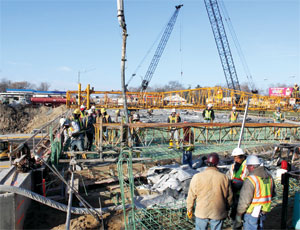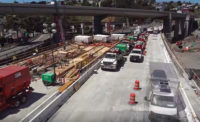Thanks in part to design-build and a lane rental arrangement, a bridge over Interstate 75 near Detroit reopened to traffic on Dec. 11, less than five months after collapsing in flames.

The steel beams of the two-span Nine Mile Bridge in Hazel Park, Mich., melted on July 15 after a car hit a tanker truck on six-lane I-75, causing 14,000 gallons of fuel to erupt in flames. “The northbound side deck fell onto the freeway,” says Gerard Pawloski, MDOT resident engineer. “The very next day our maintenance people met with four of our local contractors. Bids were due back by noon.”
Walter Toebe Construction, Wixom, Mich., Fishbeck Thompson Carr & Huber Inc., Grand Rapids, and Bergmann Associates, Rochester, N.Y., won the $11.5-million project. “We were literally designing on the fly at times. It was almost like an as-built design,” says Robert Jones, Toebe vice president. “Essentially, we did everything cast-in-place.”
The team had to accommodate a future realignment 15 ft eastward in anticipation of I-75 being widened, says Jeremy Hedden, Bergmann project manager. The 193-ft-long overpass is on spread footings. Steel piles were driven for a pier to be built when the road is realigned.
The team is charged for each day a lane, or bridge, is closed, says Pawloski. “When contractors bid on the job, they’ll estimate how many days and lane closures are needed. That becomes part of the bid. If money is left over in that pot, they get that back.”
The contract included a lane rental agreement of $10,000 per day for bridge replacement, plus a $60,000-per-day lane rental agreement for depressing I-75 next spring, says Jones. “Each category has an incentive of $200,000 for a total of $400,000,” he says. “We bid the bridge portion at $510,000 and 51 days, and the roadwork at $3,900,000 and 65 days. The bridge work wrapped up in 49 days, so we secured a small incentive of $20,000. We expect to achieve maximum incentive for the freeway work next spring.”
In April, the team will lower a half-mile of I-75 to achieve clearance of 14 ft., 9 in., from the current 14 ft., 6 in. It expects to complete the job by July. MDOT is pursuing federal emergency funds to cover up to 90% of the work.



Post a comment to this article
Report Abusive Comment